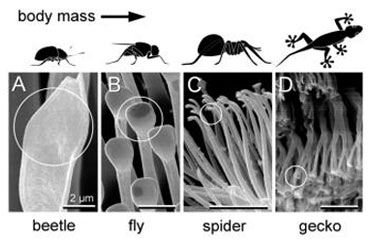GETTING STICKY WITH MATERIALS


It has been known for some time how insects, spiders and geckos have such a remarkable talent for walking on walls and ceilings. Extremely thin hairs literally stick their feet to the wall and the larger the animal, the finer the hairs. Geckos, which are heavy compared to a fly, have been using nanotechnology for this purpose for millions of years. According to findings made by scientists at the Max Planck Institute for Metals Research in Stuttgart, the shape of the fibres is also significant; for example, spatula-shaped ends on the hairs provide particularly strong adhesion.
These discoveries aroused great expectations. Is it possible to simply copy the structure of the soles of insects’ feet and before long find equivalent biomimetic, i.e. nature-inspired, adhesive materials in everyday use? The researchers at the Max Planck Institute for Metals Research and their colleauges at Gottlieb Binder GmbH in Holzgerlingen, a specialist company for fastener systems, needed plenty of staying power themselves, because the first generations of the surfaces they created with a variety of methods were not effective adhesives.
[+ more]
via material stories



0 Comments:
Post a Comment
<< Home